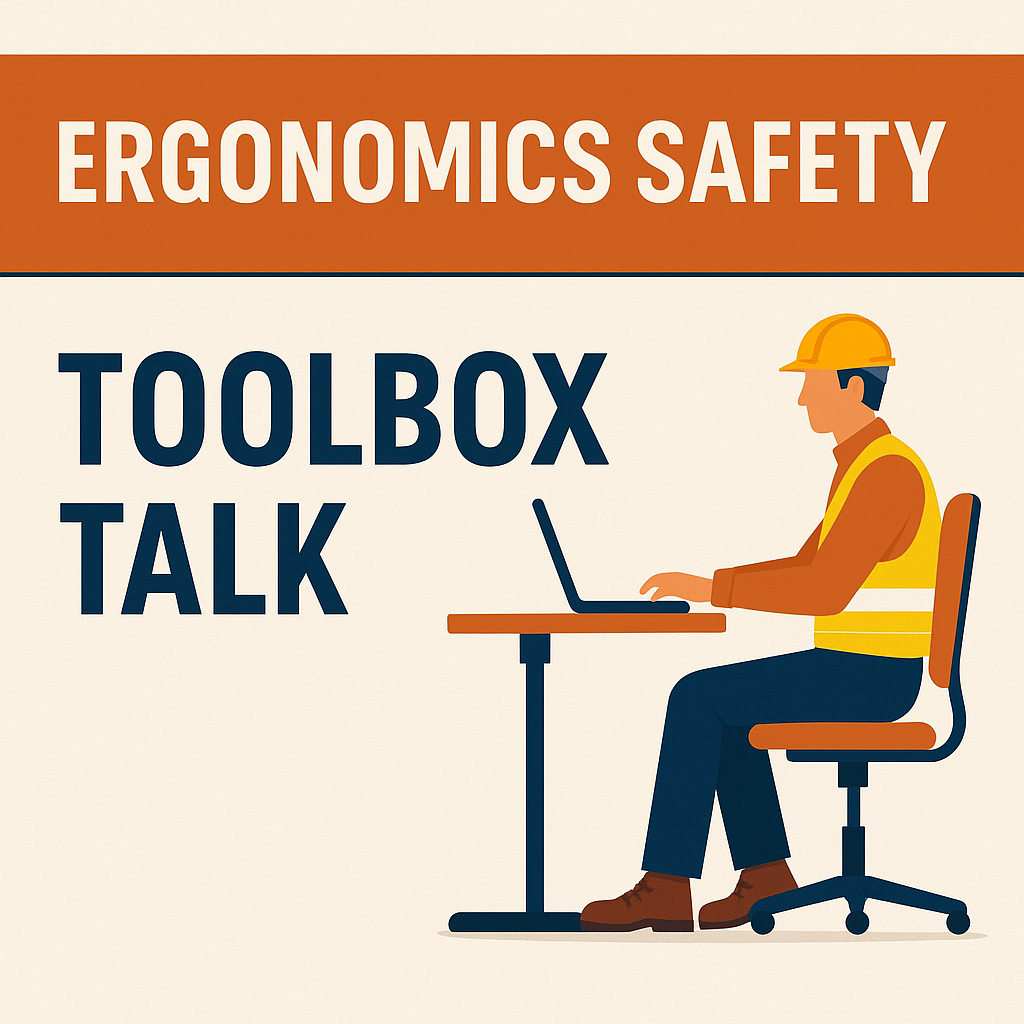
Ergonomics Safety TBT
1. Opening Greeting
Good morning team,
Today we’re going to talk about something that might not grab headlines like “fall hazards” or “electrical shocks,” but it’s a silent issue that can cause serious, long-term harm if ignored — Ergonomics Safety.
When you hear “ergonomics,” you might think of office chairs or computer keyboards, but in our work, ergonomics means something bigger: fitting the task to the worker so that your body can handle the job without strain, pain, or injury.
2. Why Ergonomics Matters
Many workplace injuries don’t happen in a split second. They build up slowly over weeks, months, or even years. These are called Work-Related Musculoskeletal Disorders (WRMSDs). They can affect your back, shoulders, neck, wrists, and knees.
Poor ergonomics can lead to:
- Chronic back pain
- Carpal tunnel syndrome
- Tendonitis
- Shoulder injuries
- Knee problems
Ignoring these early warning signs means you might end up with a condition that keeps you off work for weeks — or forces you into early retirement.
3. Common Ergonomic Hazards in Our Work
- Repetitive Motions: Doing the same action over and over, like tightening bolts or hammering.
- Awkward Postures: Working with your body twisted, bent, or reaching overhead.
- Forceful Exertions: Lifting heavy objects, pushing, or pulling with force.
- Prolonged Static Positions: Standing or kneeling for long periods without moving.
- Vibration Exposure: Using tools that vibrate, such as jackhammers or grinders.
4. Risk Factors and Warning Signs
Risk factors include:
- Workstations or tools not adjusted for your height or reach.
- Manual handling of loads without mechanical aids.
- Tools that require excessive grip force.
- Tasks that don’t allow rest breaks.
Warning signs your body might give you:
- Tingling or numbness in your hands or fingers.
- Pain in shoulders, neck, or back after a shift.
- Swelling in joints.
- Reduced range of motion.
5. Control Measures
5.1 Engineering Controls
- Use adjustable work platforms.
- Provide mechanical lifting aids like hoists or dollies.
- Design tools with ergonomic handles.
5.2 Administrative Controls
- Rotate workers between tasks.
- Schedule rest breaks to relieve muscle strain.
- Train workers on proper lifting techniques.
5.3 Work Practice Controls
- Keep loads close to your body.
- Avoid twisting your torso while lifting.
- Use both hands when possible.
- Maintain neutral postures.
6. Proper Lifting Technique
- Plan the lift — know the weight and path.
- Position your feet shoulder-width apart.
- Bend at the hips and knees, not your back.
- Keep your back straight.
- Lift smoothly, without jerking.
- Turn by moving your feet, not twisting your spine.
7. Ergonomics in Tool Use
- Choose tools with cushioned, non-slip grips.
- Avoid tools that force your wrists into awkward positions.
- Keep tools sharp and in good repair to reduce effort.
8. Real-Life Case Example
A construction worker repeatedly lifted 40 kg cement bags using a bent-back technique. After months, he developed severe lower back pain and had to undergo surgery. This could have been avoided with mechanical aids and proper lifting posture.
9. Worker Engagement Q&A
- What part of your body feels sore after a typical shift?
- How could we adjust your workstation or tools to reduce that strain?
- Can anyone demonstrate the correct way to lift a heavy load?
10. NEBOSH Exam Tip (if relevant for training)
When answering an exam question on ergonomics, always link the hazard to the body part affected, explain the risk, and state both engineering and administrative controls. This shows complete hazard management understanding.
11. Closing Words – Bringing It Back to the Start
Alright team, we began by talking about ergonomics as a way of fitting the job to the worker — not the other way around.
The truth is, injuries from poor ergonomics can sneak up on you. They don’t make a loud noise, they don’t cause immediate bleeding, but over time, they can limit your ability to work, play, or even enjoy life pain-free.
Every time you lift, push, pull, or reach — ask yourself:
- Is there an easier, safer way to do this?
- Is my body in the right position?
- Can I use a tool or device to reduce strain?
Protecting your muscles and joints now means you’ll still be able to work hard, live fully, and retire healthy.
Stay strong, stay safe, and let’s have a productive day without strain.